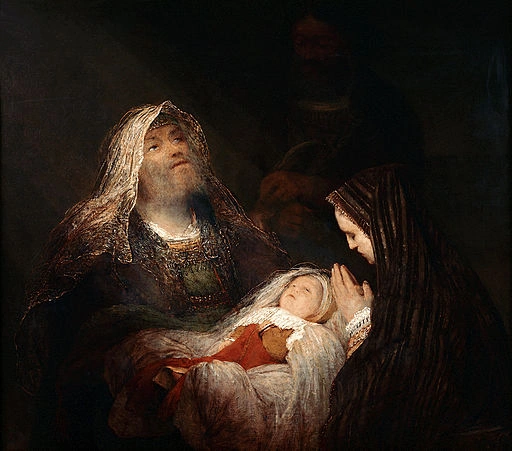
Jewish law required parents of firstborn sons to present them before the Lord at the temple in Jerusalem, after the required 33 day period of the mother's purification. Mary and Joseph duly took their new baby Jesus to Jerusalem, to the temple, for this ceremony.
Imagine how they must have been feeling as they made this 5 or 6 mile trek. They knew that they were involved in an amazing miracle, the birth of the long-awaited Messiah. They'd been visited by angels, with messages from God. Mary, a virgin, had borne a child. Mary's cousin, Elizabeth, had just had a miracle baby, too, in her old age. Her husband, Zacharias, had been visited by an angel, too, and had doubted the angel's message, and been struck dumb. On the night of Jesus's birth, shepherds had come to worship the new baby, having been told of his birth by a host of angels.
Mary and Joseph must have been feeling somewhat overwhelmed, but... they were obeying the law. Jesus had been circumcised after 8 days. Now, it was time to go to Jerusalem, so they went. Maybe, given all the miracles they'd experienced, they were expecting it to be an unusual visit. It was. The story is told very clearly in Luke 2:22-39.
At the temple, they met Simeon, and then Anna, both elderly, both good, and both drawn to the temple, ready and waiting for the Messiah. When Mary, Joseph, and Jesus arrive, they are moved by the insight that here, before their eyes, was the prophesied baby. Together they represent the essential spiritual affections—the affection for truth (Simeon) and the affection for goodness (Anna), which are necessary for “the performance of all things according to the law of the Lord” (Luke 2:39). Whenever these two qualities combine in us, we know we are in the presence of God, that the Holy Spirit is upon us, and that our eyes have seen His salvation.
The central theme of Luke's gospel is the development of the understanding. As we read the description of Simeon’s experience, we note how often the story focuses on his “sight” and on what he “sees.” We read that “it had been revealed to him by the Holy Spirit that he would not see death before he had seen the Lord’s Christ” (Luke 2:26). And when Simeon comes into the temple, he takes the Child up in his arms and says, “Lord, now You are letting Your servant depart in peace, according to your Word. For my eyes have seen Your salvation” (Luke 2:29-30).
Just as Zacharias had prophesied about “a light” that would shine in the darkness, (Luke 2:79), just as the shepherds beheld a great light — the “glory of the Lord” — shining upon them, the true Source of that light is now shining upon Simeon as he gazes upon the face of the Child. Deeply inspired, Simeon continues his prophecy: “My eyes have seen Your salvation, which You have prepared for all peoples, a light to bring revelation to the Gentiles, and the glory of Your people Israel” (Luke 2:30-32).
Turning to Mary, Simeon says, “Behold, this Child is destined for the fall and rising of many in Israel, and for a sign which shall be spoken against (yes, a sword shall pierce through your own soul also), that the thoughts of many hearts may be revealed” (Luke 2:35).
Simeon’s words are full of prophecy. There is a power that enables each of us to live according to the truth we know. And those who receive this power shall “rise,” while those who reject it shall “fall.” It is exactly as Simeon says: “Behold this Child is destined for the fall and rising of many in Israel.”
Because none of us is perfect, we will all undergo times of doubt and times of trial. There will be times when we feel the “piercing of the sword.” Even Mary would not be exempt. She would witness the horror of her own Son’s crucifixion, and feel a mother’s pain and anguish. Indeed, as Simeon had told her, “a sword shall pierce through your own soul also.”
It’s part of the journey. While our suffering might not be as great as Mary’s when she stood near the cross, nor as grievous as Jesus’ as He was crucified, there will be times when we too will experience sorrow, loss, and grief—times that may be so painful that it will feel as though a sword has pierced through our own soul. But these times are not to be avoided or feared. They can instead be opportunities to renew our faith, confirm our belief in God, and resolve to go forward. These are the times when our most cherished values will be challenged, and our deepest thoughts will be made manifest. These times and these trials are allowed to come into our lives so that our true nature may be exposed and “the thoughts of many hearts may be revealed.”
But no matter how desperate our situation, or how grievous our trials, there is still a quiet place in our hearts that waits patiently for God. This faith is represented by Anna the prophetess, who, like Simeon, is led to the temple at that very moment. After a seven-year marriage, she remained as a widow for many years. Now, at the age of eighty-four, she has never departed from the temple. Instead, she has chosen to remain faithful, “serving God with fasting and prayers night and day” (Luke 2:37).
This is not a one-time experience. It is an experience which continues to grow within us, an experience which becomes stronger over time. As it is written, “And the Child grew and became strong in spirit, filled with wisdom; and the grace of God was upon Him” (Luke 2:39).
If we can be like Simeon -- loving to see truth, and Anna, loving to be good -- we will be ready, and listening, and willing to be moved by the spirit, and we will see the Lord born in our lives.



